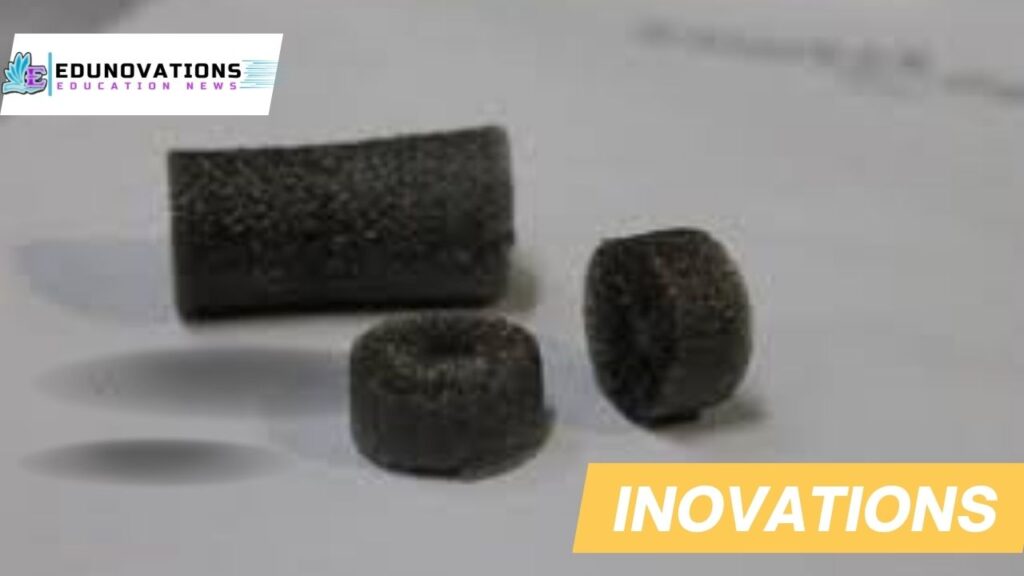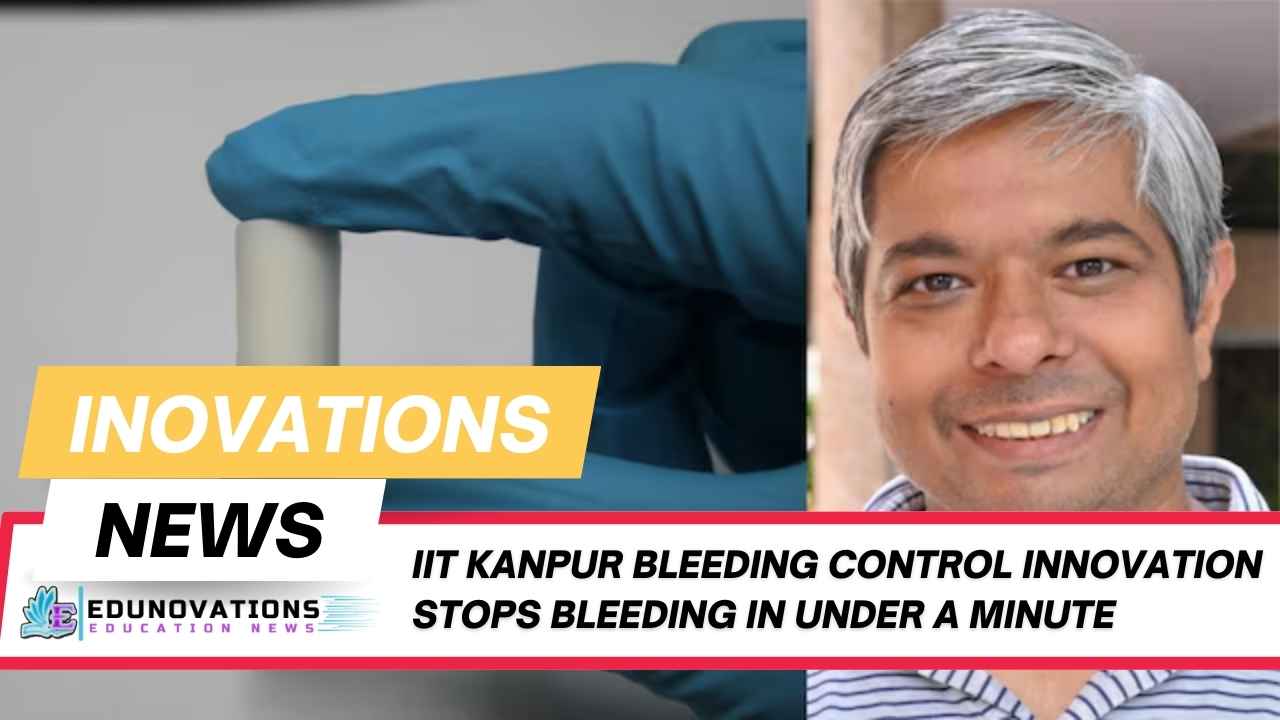Groundbreaking Innovation: IIT Kanpur Scientists Develop Life-Saving Technology to Stop Bleeding in Under a Minute. This IIT Kanpur bleeding control innovation can save millions of Lives.
Introduction for IIT Kanpur bleeding control innovation
In a pioneering breakthrough that is poised to reshape emergency medicine, scientists at IIT Kanpur have developed a revolutionary technology that stops bleeding in less than a minute. This novel approach, which represents a significant leap forward in hemostatic solutions, promises to save countless lives, reduce emergency response times, and transform surgical procedures around the globe. By integrating cutting-edge material science with advanced biomedical engineering, the research team has created an innovation that could change the face of trauma care and battlefield medicine.
Recent tests and early clinical trials have showcased the potential of this advanced hemostatic technique developed at IIT Kanpur. Not only does it offer rapid bleeding control, but it also minimizes tissue damage and accelerates healing. This breakthrough is already attracting attention from medical professionals and policymakers alike, setting the stage for a new era in life-saving medical interventions.
Unveiling the Technology Behind the Breakthrough
At the heart of this innovation is a meticulously engineered composite material that instantly coagulates blood upon contact. The technology deploys a unique blend of biocompatible compounds designed to interact with the body’s natural clotting factors, triggering a rapid cascade of reactions that seal wounds within moments.
How IIT Kanpur bleeding control innovation Works
This life-saving medical breakthrough IIT Kanpur engineers describe as a game-changer. The technology leverages a rapid bleeding control technology that works by:
- Immediate Activation: The composite material instantly absorbs the blood, concentrating clotting factors to expedite the coagulation process.
- Enhanced Tissue Adhesion: The material adheres strongly to damaged tissues, ensuring that the bleeding site is sealed effectively even under high-pressure scenarios.
- Biocompatibility: Made entirely from materials that are safe for human use, the innovation reduces the risk of adverse reactions and inflammation.
- Rapid Degradation: Once its job is done, the material gradually degrades, allowing natural healing processes to take over without the need for surgical removal.
These properties combine to create an innovative bleeding stoppage technology that brings rapid hemostatic response to the forefront of modern medical treatment. The researchers underscore that this technology not only provides immediate control of hemorrhage but also supports a favorable healing environment, minimizing scarring and tissue damage.
Development Process and Testing of IIT Kanpur bleeding control innovation
The journey to developing this rapid bleeding control technology was characterized by rigorous experimentation and collaboration across various disciplines. From initial prototypes to animal model testing, each phase focused on safety, efficacy, and ease of application in real-world scenarios. Laboratory tests demonstrated that the material could achieve hemostasis in less than a minute, outperforming many conventional products used in emergency care.
Clinical experts have lauded this life-saving medical breakthrough IIT Kanpur method as one of the most promising interventions in trauma care. The material’s performance under extreme conditions and its adaptability for different types of wounds have provided a strong foundation for its potential future use in hospitals, ambulances, and even remote field settings.
A Closer Look at the Science

Material Science and Biomedical Engineering
The breakthrough is the result of advanced research at the intersection of material science and biomedical engineering. By studying natural clotting mechanisms, IIT Kanpur scientists synthesized a material that mimics and enhances these biological processes. The team combined laboratory research, computer modeling, and real-world testing to optimize the formulation.
This advanced hemostatic technique IIT Kanpur researchers designed is built on a foundation of innovative polymer chemistry and nanotechnology. These fields have converged to produce materials that are not only effective in preventing blood loss but also safe to use on delicate human tissues. The integration of nanotechnology allows for precise control over the material’s structure, ensuring uniform performance across different injury types.
Benefits Over Traditional Methods
Traditional methods for controlling bleeding often involve gauze dressings, surgical clamps, or chemical agents that may take several minutes to work and often come with complications such as infection or inflammation. In contrast, the IIT Kanpur bleeding control innovation offers several advantages:
- Speed: Stops bleeding in less than a minute, which is critical in trauma and emergency settings.
- Safety: Uses biocompatible materials that reduce the risk of adverse reactions.
- Versatility: Can be used across a wide range of injuries, from superficial cuts to deep lacerations.
- Ease of Use: Simple application process makes it ideal for both first responders and surgical teams.
The efficiency of this technology is underscored by its potential to reduce mortality rates in trauma scenarios significantly, particularly in situations where every second counts.
Transformative Implications for Emergency Medicine
Impact on Trauma Care
Traumatic injuries, whether from accidents, warfare, or natural disasters, often require immediate intervention to prevent life-threatening blood loss. The IIT Kanpur bleeding control innovation is set to become an invaluable tool in emergency medicine, particularly in pre-hospital care. With its ability to rapidly coagulate blood, this technology could reduce the time between injury and definitive care, leading to improved patient outcomes.
In emergency settings like ambulances and battlefield medical stations, where resources and time are extremely limited, the availability of a fast-acting hemostatic solution could mean the difference between life and death. Medical experts predict that widespread adoption of this technology could lead to a significant decrease in preventable deaths due to hemorrhage.
Revolutionizing Surgical Procedures
The advantages of this bleeding cessation technology extend into the operating room as well. Surgeons often face challenges managing blood loss during complex procedures. By integrating this innovative bleeding stoppage technology into surgical protocols, it is possible to reduce the risks associated with excessive bleeding, thereby improving surgical outcomes.
- Reduced Operation Time: Faster hemostasis can shorten surgery duration, reducing the risk of complications associated with prolonged operations.
- Enhanced Precision: Surgeons can focus on the primary procedure without frequent interruptions to manage bleeding.
- Cost-Effectiveness: Reduced need for blood transfusions and associated interventions lower the overall cost of care.
This dual-use nature of the innovation—benefiting both emergency and planned surgical settings—highlights its potential as a transformative tool in modern healthcare.
Broader Applications and Future Prospects
Battlefield and Remote Medicine
One of the most promising applications for this life-saving innovation is in military and remote medicine. Armed forces and disaster response teams often operate in challenging environments where immediate access to advanced medical facilities is limited. This bleeding control innovation, with its portable and easy-to-apply format, is ideally suited for such situations.
Potential for Widespread Adoption
The researchers at IIT Kanpur have already begun discussions with several global medical device companies and government agencies about large-scale production and distribution. The goal is to integrate this rapid bleeding control technology into national emergency response protocols and military medical kits.
Furthermore, extensive collaborations are underway with healthcare providers to conduct more extensive clinical trials. These studies aim to gather robust data on the efficacy and safety of the technology, paving the way for regulatory approvals and global acceptance.
Economic and Social Impact
The economic implications of this breakthrough could be significant. By reducing the need for costly blood transfusions and prolonged hospital stays, the IIT Kanpur bleeding control innovation could reduce healthcare costs substantially. Moreover, the technology’s ability to save lives and improve recovery times could have far-reaching social benefits, especially in low-resource settings where advanced medical care is often scarce.
Experts predict that the implementation of such innovations in national health systems could lead to a reduction in trauma-related mortality rates by a considerable margin. As nations invest in healthcare infrastructure upgrades, technologies like this one offer a promising avenue for improving public health outcomes on a global scale.
Expert Insights and Industry Perspectives
Leading medical professionals and biomedical engineers have emphasized the importance of innovations such as this one in enhancing emergency care standards. Dr. A. K. Singh, a renowned trauma surgeon, commented on the development:
“The IIT Kanpur team has achieved something remarkable. This bleeding control innovation could redefine the standard of care in trauma management and surgeries worldwide.”
Additionally, industry analysts note that the integration of this technology could trigger a paradigm shift in how healthcare systems approach emergency treatment. With rising global healthcare costs and increasing incidents of trauma due to accidents and conflicts, fast-acting hemostatic agents are not just a luxury but a necessity.
Furthermore, statistical data from recent studies suggest that rapid response to hemorrhage could improve survival rates by 30-40% in critical cases. These numbers not only underscore the clinical significance of the breakthrough but also highlight the urgent need for further research and investment in advanced hemostatic technologies.
Integration with Existing Medical Protocols
The seamless integration of this breakthrough into existing medical protocols is critical for maximizing its impact. Healthcare administrators are exploring ways to incorporate the IIT Kanpur bleeding control innovation into pre-hospital emergency kits, trauma centers, and even routine surgical practice.
Implementation Strategies
- Training Programs: Establishing comprehensive training for first responders and surgical teams on the application of the new technology.
- Standard Operating Procedures: Updating existing protocols to include steps for the rapid application of the hemostatic material.
- Collaborative Research: Partnering with leading hospitals to conduct real-world trials and gather extensive data on performance.
The proactive approach by medical institutions to adopt such innovations is expected to create a ripple effect across the healthcare industry, setting new standards for patient care and surgical efficiency.
Future Directions and Research Opportunities
Ongoing Research Initiatives
While the current results are promising, further research is essential to refine the technology and expand its applications. Researchers are particularly interested in exploring:
- Long-Term Biocompatibility: Studying the body’s interaction with the material over extended periods.
- Customization for Different Wound Types: Tailoring the composition to suit various injury patterns, from superficial cuts to deeper lacerations.
- Integration with Regenerative Medicine: Enhancing the material with growth factors to promote faster tissue repair.
Challenges and Regulatory Considerations
Despite the promising results, several challenges remain. Scaling up production while maintaining consistent quality, ensuring long-term safety through rigorous clinical trials, and navigating complex regulatory pathways are some of the hurdles that scientists and industry stakeholders must overcome. Transparent communication and adherence to strict regulatory standards will be essential to ensuring public trust and global adoption of the innovation.
Additional Resources for Further Learning
For those interested in exploring related topics and deepening their understanding of biomedical innovations, the following resources are available:
- For NCERT Courses: NCERT Courses
- For Current Affairs: Current Affairs
- For Notes: Detailed Notes
- For MCQs: Practice MCQs
- For Videos: Informative Videos
- For Syllabus Details: Syllabus Overview
- For Downloads of Free NCERT PDFs: Free NCERT PDFs
- For NCERT Mind Maps: NCERT Mind Maps
For schools seeking cutting-edge digital solutions, visit Need Website for Schools Contact.
FAQs
1. What is the IIT Kanpur bleeding control innovation?
The innovation is a rapidly acting composite material that stops bleeding by accelerating the body’s natural clotting mechanisms, achieving hemostasis in less than a minute.
2. How does the technology work?
It works by immediately absorbing blood, concentrating natural clotting factors, and rapidly forming a secure seal over the injury site through enhanced tissue adhesion and biocompatibility.
3. What makes this technology different from traditional methods?
Unlike traditional methods, which often require longer times to control hemorrhage and may involve additional risks, this advanced hemostatic technique offers faster response, improved safety, and versatility across different types of wounds.
4. Can this technology be used in emergency and surgical settings?
Yes, the innovation is designed for both pre-hospital emergency care and surgical applications, making it ideal for reducing blood loss in trauma situations as well as during complex surgical procedures.
5. Has the technology undergone clinical testing?
Initial trials and laboratory tests have shown promising results in terms of efficacy and safety. Ongoing research and clinical trials are being conducted to further validate its performance in real-world scenarios.
6. What are the potential benefits for trauma care?
The technology can significantly decrease the time required to control bleeding, thus reducing the risk of death and complications from severe blood loss, especially in settings where immediate medical help is limited.
7. How might this breakthrough impact military medicine and remote healthcare?
Due to its rapid action and ease of application, the innovation is well-suited for use in battlefield and remote environments where quick and efficient bleeding control is critical to saving lives.
8. What are the main challenges in bringing this technology to market?
Key challenges include scaling up production while ensuring quality, navigating regulatory approvals, and conducting further long-term studies to confirm biocompatibility and effectiveness.
9. How does this innovation benefit the overall healthcare system?
By reducing surgery times, lowering the need for blood transfusions, and cutting healthcare costs, the breakthrough has the potential to significantly improve patient outcomes and the efficiency of medical care services.
10. Where can I find more information or related educational resources?
You can explore additional topics related to medical innovations and current affairs through resources like NCERT Courses, Current Affairs, and Detailed Notes.
In summary, the IIT Kanpur bleeding control innovation represents a monumental leap forward in medical science. By harnessing advanced materials and engineering, this breakthrough offers a rapid, reliable, and safe solution to one of medicine’s most urgent challenges. As the technology moves closer to widespread clinical implementation, its impact is expected to resonate across emergency services, surgical suites, military medicine, and beyond—truly marking a new era in life-saving medical interventions.









